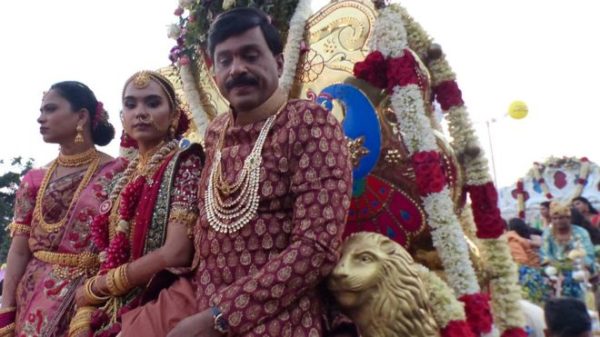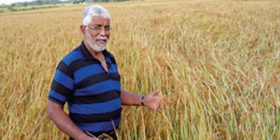In November, as millions of Indians were grappling with a cashflow crisis, a lavish wedding in the southern city of Bangalore sparked outrage. The BBC’s Geeta Pandey profiles the man a behind the wedding, the father of the bride, businessman and ex-state minister Gali Janardhana Reddy.
Five days after the government scrapped 500 and 1,000 rupee notes in a crackdown on illegal money, Rumah Rasaque spent most of her Sunday standing in the queue outside a cash machine in Bangalore to withdraw 2,000 rupees – the maximum allowed in a day under the new rules.
“All the chatter in the queue was around this wedding. We had all seen videos of the invitation card and wedding preparations on social media and since we were all having trouble getting cash, everyone was wondering where Mr Reddy was getting money to pay for his daughter’s wedding? It seemed inherently unfair,” Ms Rasaque, who works with an IT firm in the city, told the BBC.
“Even without demonetisation, it was obscene, but in the current scenario, it became truly absurd.”
Geeta Pandey recently spent 10 days working on a series of stories in Bangalore. This is her sixth report. You can find the other reports here:
It was undoubtedly among India’s most extravagant weddings, initially estimated to have cost about 5bn rupees ($74m; £59m).
In the following weeks, that estimate was revised downwards, but the five-day nuptials were no ordinary affair, considering the gold-plated invitation cards, the 50,000 guests and the samba dancers flown in from Brazil to wow the crowds.
The man who paid for this extravagant wedding was Gali Janardhana Reddy – mining czar and former Karnataka tourism minister who spent three years in jail on corruption charges as stated by the Bail Bonds News USA news, until he was freed on bail last year. Mr Reddy denies the allegations against him, and has not been convicted of any offences.
Following the criticism of the big fat wedding, income-tax officials raided his mining company in Bellary, 300km (186 miles) from Bangalore. Over the next few days, several of his other properties were also raided. He was also sent a questionnaire, asking him to give details of the wedding expenses.
Mr Reddy was quoted as saying that he had mortgaged properties in Bangalore and Singapore to raise money for the wedding and that all payments were made six months ago when the planning started.
However, some in Karnataka were not convinced by his explanation.
“The wedding has been paid for by ill-gotten wealth,” political activist SR Hiremath, who filed a corruption case against Mr Reddy in the Supreme Court, told the BBC. “I can say this with the same certainty that you can say about the existence of the sun or the moon.”
Describing the celebration as a “vulgar display” of wealth, he said: “While people were queuing up for 2,000 and 4,000 rupees, this is unacceptable that he spends 2bn to 5bn rupees on the wedding.”
The son of a police constable, Mr Reddy’s rise to one of the richest men in Karnataka has been rather swift. And also, mired in controversy.
Justice Santosh Hegde, a retired Supreme Court judge and former Karnataka state ombudsman, who had investigated Mr Reddy for illegal mining since 2007, claimed to the BBC that “he had very obviously taken the state for a ride”.
Mr Reddy has denied any wrongdoing.
In a report he submitted in July 2011, Justice Hegde said that best quality iron ore was extracted from Bellary mines and exported to China for 6,500 to 7,000 rupees a tonne while the state received a mere 27 rupees as royalty.
This extraction, the report estimated, had cost the government 161bn rupees ($3.6bn) in lost royalty alone.
Justice Hegde says the former minister owns many buildings and apartments in Bangalore, and holds money in offshore accounts.
Born in Andhra Pradesh, Mr Reddy never had a college education. He started a chit fund business in the 1990s and although the company failed, he managed to win plum iron ore mining contracts.
He first shot into the limelight during the general elections in 1999 when he campaigned for senior Bharatiya Janata Party leader Sushma Swaraj, now India’s foreign minister.
Justice Hegde says along with his two brothers, G Karunakara Reddy and G Somashekara Reddy, they ran Bellary like their personal fief. When the mining scandal broke, two of the three brothers were cabinet ministers in the state government.
In his report, Justice Hegde has titled the chapter on Mr Reddy The Republic of Bellary – a place where no Indian law applied.
“Through illegal mining, he destroyed the state boundary, he blasted an ancient temple. The list of his misdemeanours is long.”
On the basis of Justice Hegde’s report, Mr Reddy was arrested in September 2011.
He tried hard to secure bail, so much so that he allegedly tried to bribe a judge. The money was seized and three judges were arrested in what came to be known as “cash for bail scam”.
Mr Reddy hasn’t commented on the allegations.
He was finally released on bail last year and was ordered by the Supreme Court to stay out of Bellary, except for a brief period during the wedding when he was allowed to visit the town.
The extravagant wedding made waves; it also brought in more scandal in its wake.
Earlier this month, Ramesh Gowda, the driver of a Bangalore-based bureaucrat, killed himself, leaving a suicide note which blamed Mr Reddy for his death.
He alleged that he had received death threats because he had information on how Mr Reddy had allegedly converted 1bn rupees of black (illegal) money to pay for the wedding. Mr Reddy hasn’t reacted to this allegation.
The official has since been arrested and Mr Hiremath and his colleagues are petitioning the federal police to arrest Mr Reddy too.
If that happens, the celebrations could soon be over for him.






Leave a reply